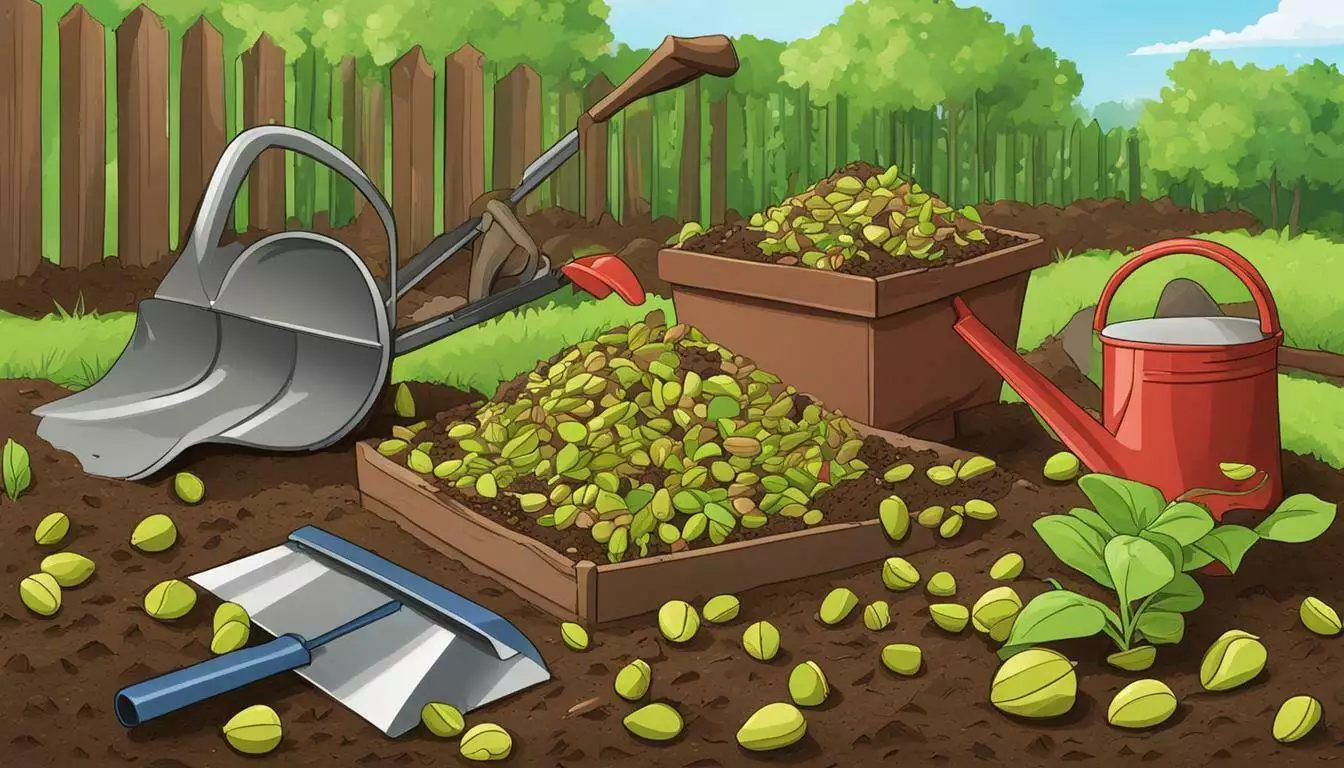If you’ve ever wondered if pistachio shells can be composted, you’re not alone. Many people are unsure about whether or not these shells can be added to their compost pile. The good news is that pistachio shells are indeed compostable and can be a valuable addition to your composting routine. However, there are a few things you need to keep in mind to ensure proper composting of pistachio shells.
Key Takeaways:
- Pistachio shells are compostable and can be added to your compost pile.
- Proper preparation is important – clean and dry the shells, and break them down into smaller pieces.
- Mix the pistachio shells with other compostable materials for efficient decomposition.
- Composted pistachio shells can be used as soil amendment or mulch, providing nutrients and improving soil structure.
- Be cautious with the use of composted pistachio shells due to their potential high salt content.
How to Compost Pistachio Shells: A Sustainable Guide
Composting pistachio shells can be a valuable addition to your compost pile, but it is important to follow a few steps to ensure efficient decomposition. First, start by cleaning and drying the shells thoroughly. This will help prevent any mold or fungus growth in your compost. Once they are clean and dry, break them down into smaller pieces. This will speed up the decomposition process and ensure that the shells integrate well with other organic materials in your compost pile.
When adding the pistachio shells to your compost, make sure to mix them with other compostable materials such as kitchen scraps, yard waste, and leaves. This will help balance out the carbon-to-nitrogen ratio and create a nutrient-rich compost. Remember to turn your compost pile regularly to maintain proper aeration and moisture levels. This will help speed up the decomposition process and result in a well-balanced compost.
Once the pistachio shells have fully decomposed, you can use the compost as a soil amendment or as mulch for your plants. Composted pistachio shells provide essential nutrients to the soil, improving its fertility and structure. However, it’s important to note that pistachio shells can be high in salt, so it’s best to use them sparingly. A little goes a long way when it comes to benefiting your plants.
Remember:
“Composting with pistachio shells allows you to reduce waste and create nutrient-rich compost for your garden. Just make sure to clean, dry, and break down the shells before adding them to your compost pile. Mix them with other organic materials, turn your compost regularly, and enjoy the benefits of sustainable gardening!”
By following these simple steps, you can turn your pistachio shells into a valuable resource for your garden while reducing waste. Composting with pistachio shells is an eco-friendly way to make the most of these kitchen leftovers and contribute to a more sustainable environment.
Conclusion: The Sustainable Potential of Pistachio Shells
Composting pistachio shells not only helps with waste reduction but also provides valuable nutrients and improves soil structure. These shells, although they take a long time to break down, can be a valuable addition to your compost pile. To prepare them properly, start by cleaning and drying the shells. Then, break them down into smaller pieces to facilitate decomposition.
Mixing the pistachio shells with other compostable materials in your pile is crucial for efficient decomposition. Remember to maintain your compost pile properly, ensuring a good balance of carbon-rich and nitrogen-rich materials. This will help speed up the breakdown process, creating nutrient-rich compost for your garden.
Once the pistachio shells have fully decomposed, you can use the composted shells as a soil amendment or as mulch for your plants. They provide nutrients to the soil and improve its structure, promoting healthy plant growth. However, it’s important to note that pistachio shells can be high in salt content, so it’s best to use them sparingly. Excessive use of pistachio shell compost may lead to an imbalance in soil chemistry, affecting plant health.
In conclusion, composting pistachio shells not only contributes to waste reduction but also offers sustainable benefits for your garden. By following proper composting practices and using the resulting compost wisely, you can create a more eco-friendly gardening routine while nurturing your plants with nutrient-rich soil.
FAQ
Can pistachio shells be composted?
Yes, pistachio shells can be composted. They are high in carbon and can help balance out nitrogen-rich materials in your compost pile.
How should I prepare pistachio shells for composting?
To prepare pistachio shells for composting, you should clean and dry them. Then, break them down into smaller pieces to aid in decomposition.
What should I mix pistachio shells with in my compost pile?
You should mix pistachio shells with other compostable materials, such as kitchen scraps, yard waste, and dry leaves. This will help create a diverse mix of organic matter for efficient decomposition.
How long does it take for pistachio shells to break down in the compost?
Pistachio shells can take a long time to break down in the compost. The process can range from several months to a year or more, depending on various factors such as moisture, temperature, and the size of the shell pieces.
What can I do with composted pistachio shells?
Composted pistachio shells can be used as a soil amendment or as mulch for plants. They provide nutrients to the soil and improve its structure. However, it is best to use them sparingly as they can be high in salt.

